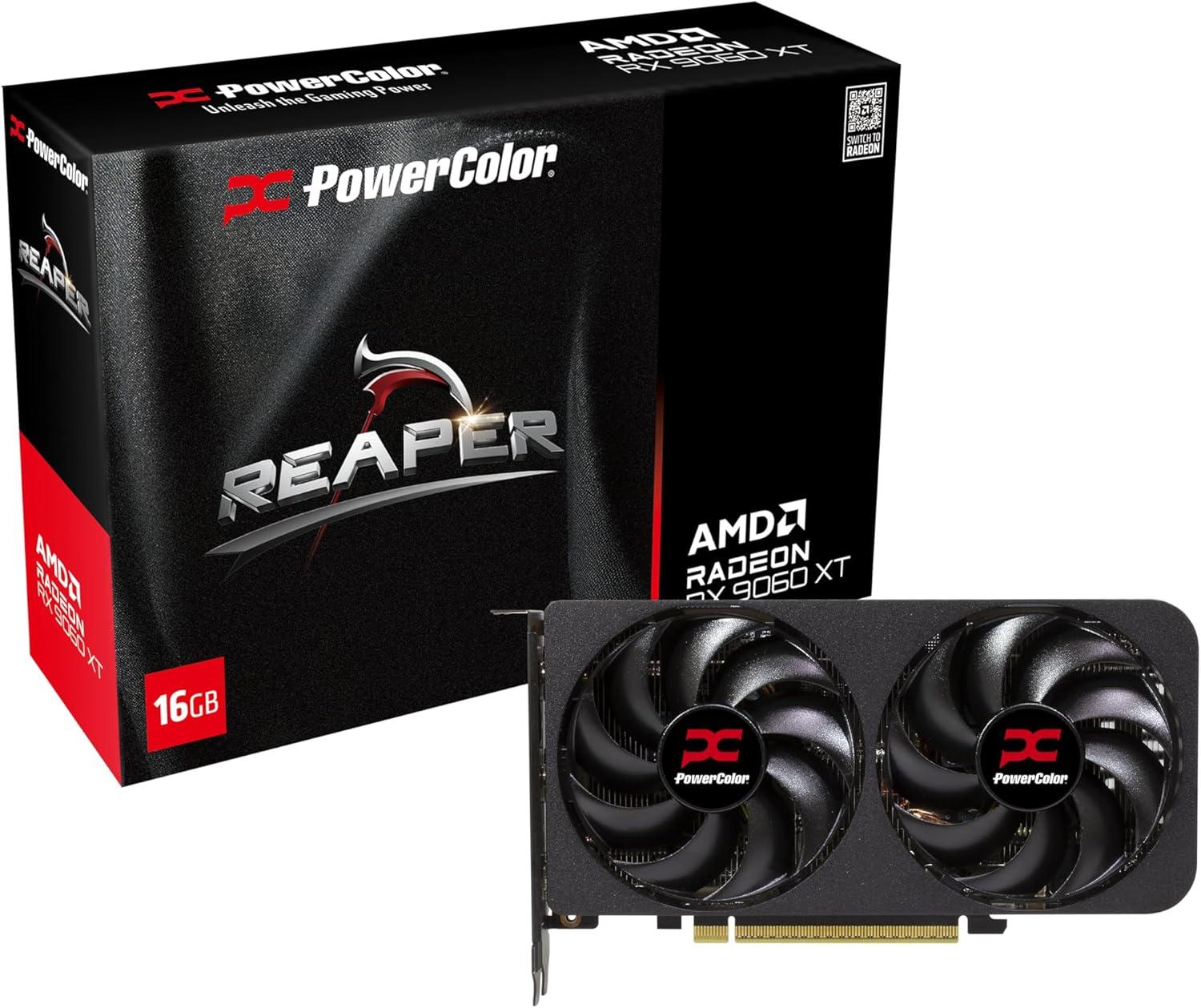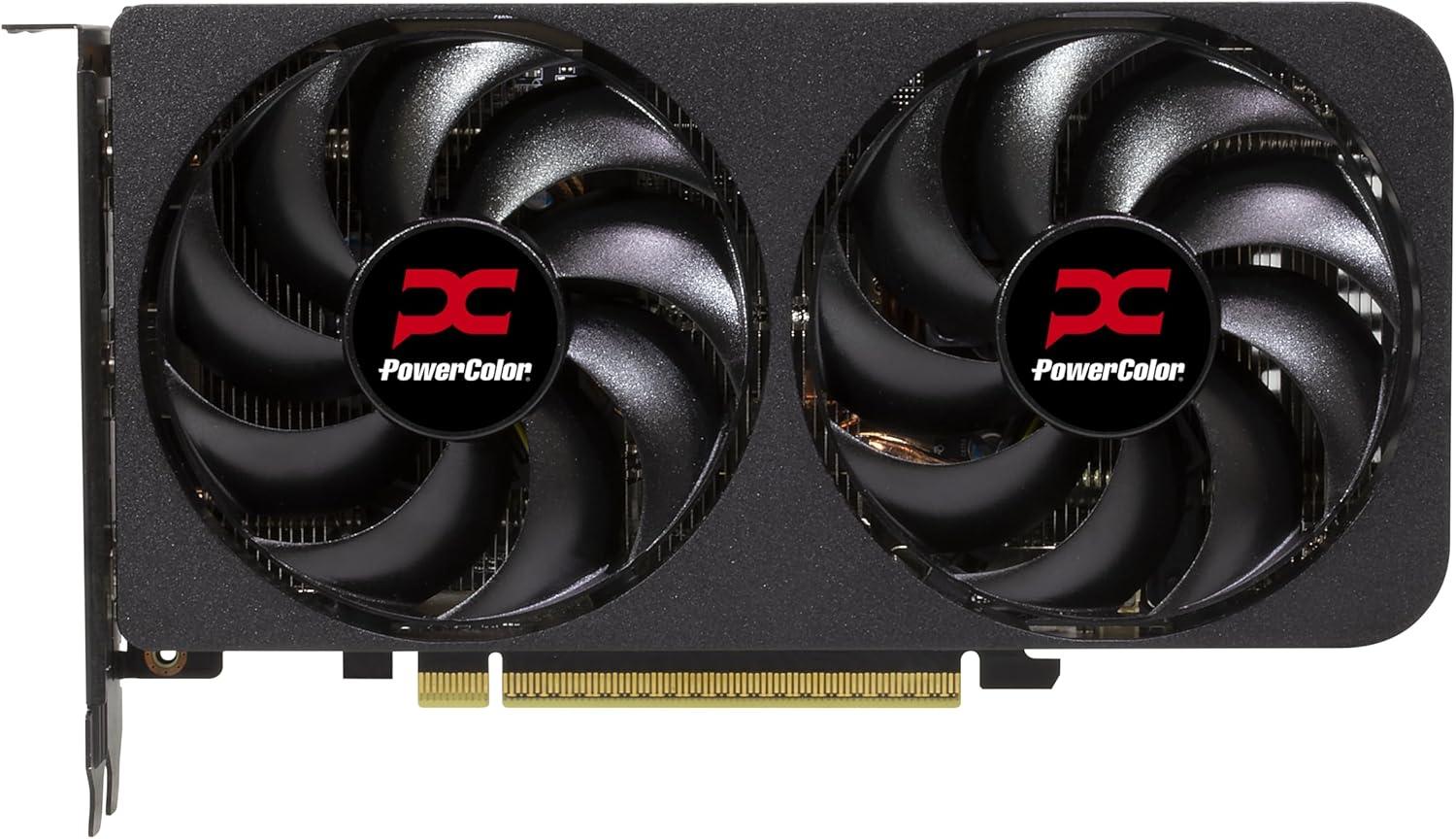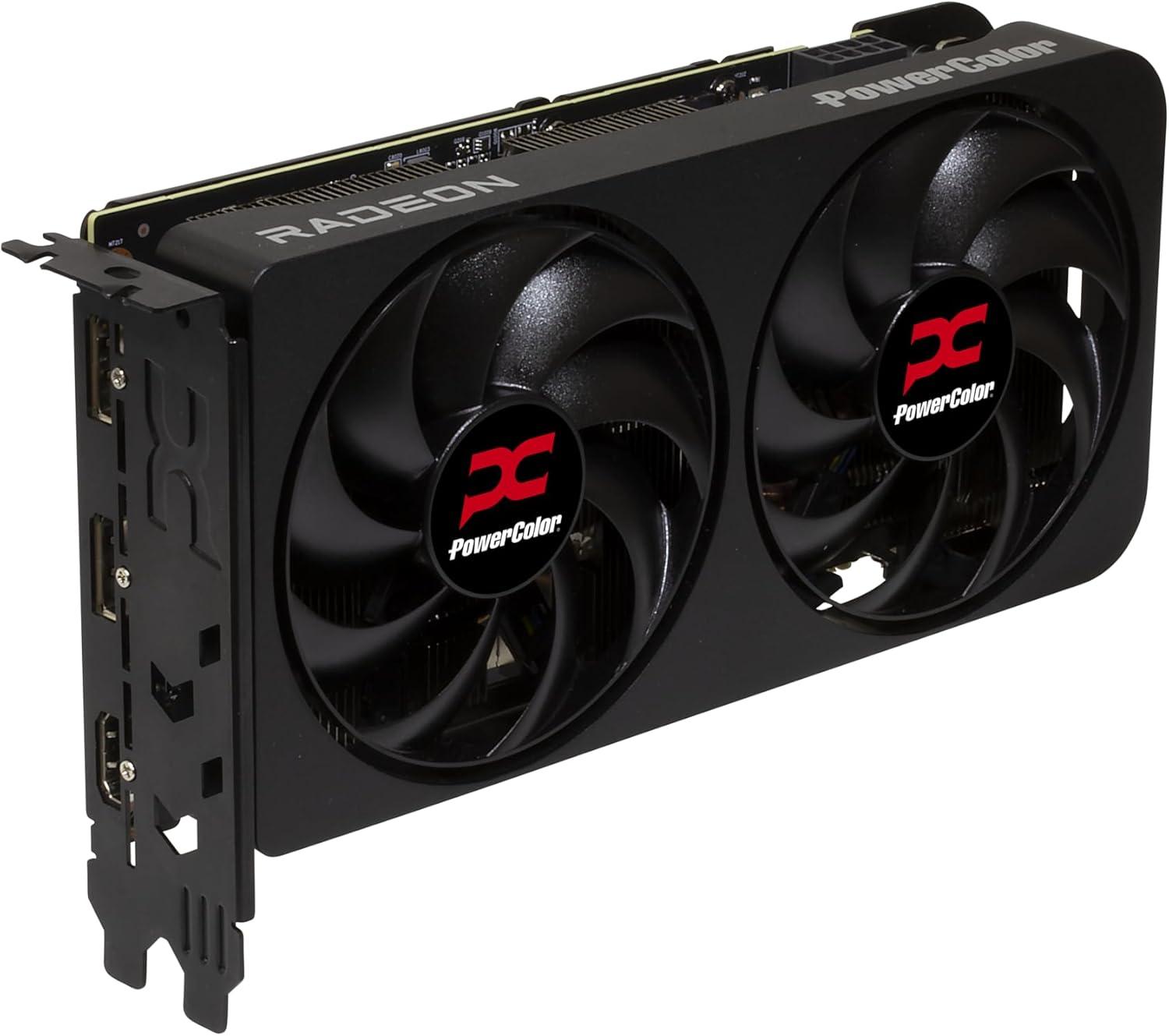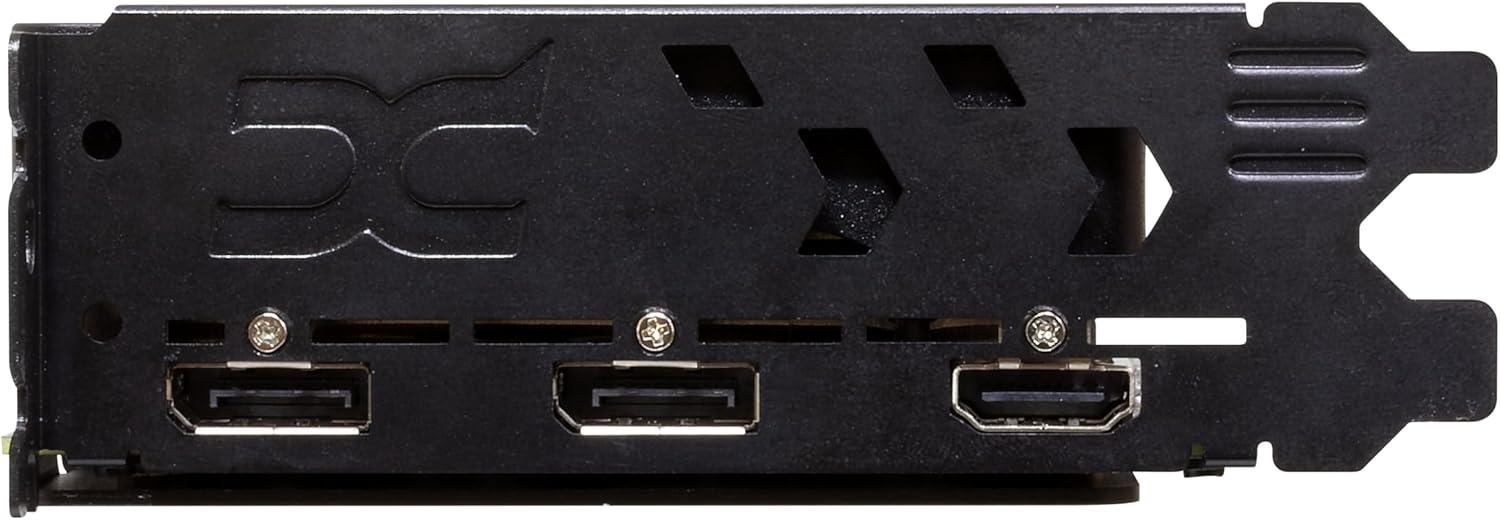PowerColor Reaper AMD Radeon RX 9060 XT 16GB
RX 9060 XT 16GB Review & Specifications
The RX 9060 XT 16GB is based on the RDNA 4.0 architecture and manufactured using the 4 nm process node. It was launched approximately 3 weeks, 6 days ago, originally priced at $349. It features 2048 cores, including 32 compute units (SMs), 128 texture mapping units (TMUs), and 64 render output units (ROPs). For ray tracing and AI-accelerated tasks, it also includes 32 dedicated RT cores and None Tensor cores, enabling advanced rendering and upscaling features where supported. It has a base clock of 1700 MHz and a boost clock reaching up to 3130 MHz. The RX 9060 XT 16GB comes equipped with 16 GB of GDDR6 memory across a 128-bit bus. Memory runs at 2518 MHz and delivers a total memory bandwidth of 322 GB/s.
This GPU has a low thermal design power (TDP) of 160 W. It is generally compatible with almost all PC cases and is excellent for SFF and compact systems where heat dissipation is a concern.
RX 9060 XT 16GB Performance
RX 9060 XT 16GB is a mid-range graphics card, scoring 42.77% in relative gaming performance. Thanks to 16 GB of VRAM, it offers excellent 1440p performance and can handle 4K gaming with optimized settings or the help of DLSS, FSR, and frame generation. Great for users targeting 100+ FPS at 1440p or playable 4K in lighter titles.
The RX 9060 XT 16GB is equipped with a generous 16 GB of VRAM, providing excellent performance in a wide range of use cases. It can handle ultra to high settings in most modern games at up to 4K resolution with minimal compromise. It also supports features such as ray tracing and high-resolution textures without significant memory constraints. For content creators, this GPU is well-suited for 4K video editing, photo editing with large RAW files, 3D rendering, and complex animations. In AI applications, it can run intermediate-sized models and perform tasks such as training custom models, image generation, and data processing — though not at the scale of enterprise-class GPUs. It offers a great balance for gamers, creators, and prosumers alike.
In terms of gaming value, PowerColor Reaper AMD Radeon RX 9060 XT 16GB offers excellent performance per dollar, achieving 85.8% efficiency relative to the best in this category. It is an outstanding choice for users seeking a cost-effective yet powerful solution, with ample VRAM ensuring strong future-proofing.
GPU Information
GPU Name: RX 9060 XT 16GB
GPU Code Name: Navi 44
Release Price: $349
Launch Date: 3 weeks, 6 days ago.
Architecture / Process: RDNA 4.0 / 4 nm
Cores / CUs (SMs) : 2048 / 32
TMUs / ROPs: 128 / 64
RT Cores / Tensor Cores: 32 / None
Base / Boost Clock: 1700 MHz / 3130 MHz
Memory: 16 GB GDDR6, 128 bit
Memory Clock / Bandwidth: 2518 MHz / 322 GB/s
Transistors: 29700 million
TDP: 160 W
Graphics Card Information
Name: PowerColor Reaper AMD Radeon RX 9060 XT 16GB
Manufacturer: PowerColor
Graphics Card Available: True
Current Price Amazon: $369
Amazon Price Updated: 2 days, 9 hours ago.
Factory GPU Clock: 3230 MHz
Memory Clock: 20 Gbps effective
Dimensions: 220mm*120mm*40mm
Power Connector: 8 pin x 1
Display Output: 1 x HDMI 2.1b,2 x DisplayPort 2.1a
Performance
Pixel Rate: 200.30 GPixel/s
Texture Rate: 400.60 GTexel/s
FP16: 51.28 TFLOPS
FP32: 25.64 TFLOPS
FP64: 801.30 GFLOPS
Gaming Performance
1080p: 42.77%
1440p: 35.98%
2160p: 29.91%
Calculated Performance
Performance per Price: 85.8%
RX 9060 XT 16GB Compared to Similar Performance GPUs
GPU Price / Performance Table
| GPU (Desc) | Price (Desc) | Gaming_1080p (Desc) | Gaming_1440p (Desc) | Gaming_2160p (Desc) | Game_1440p/Price (Desc) |
|---|---|---|---|---|---|
|
$479
|
↓
-4.0%
|
45.2%
|
38.5%
|
31.7%
|
70.8%
|
|
|
$449
|
↓
-23.8%
|
43.9%
|
38.2%
|
31.5%
|
74.8%
|
|
|
$599
|
0.0%
|
44.0%
|
37.4%
|
32.1%
|
55.0%
|
|
|
$409
|
0.0%
|
44.6%
|
36.6%
|
25.7%
|
78.7%
|
|
|
$419
|
↑
10.6%
|
42.8%
|
36.0%
|
29.9%
|
75.6%
|
|
|
$490
|
↓
-1.8%
|
42.5%
|
35.7%
|
30.6%
|
64.2%
|
|
|
$399
|
0.0%
|
40.3%
|
33.8%
|
28.5%
|
74.5%
|
|
|
$299
|
0.0%
|
40.9%
|
33.2%
|
25.5%
|
97.6%
|
|
|
$599
|
0.0%
|
38.8%
|
32.8%
|
28.7%
|
48.2%
|
GPU Specification Table
| GPU (Desc) | Architecture | Shader/TMU/ROP/RT | Base/Boost Clock | Memory | Mem Clock/Bandwidth | TDP |
|---|---|---|---|---|---|---|
| RTX 5060 Ti 16GB | GB206 / 4 nm / Blackwell 2.0 | 4608 / 144 / 48 / 36 | 2407 MHz / 2572 MHz | 16 GB GDDR7 / 128 bit | 1750 MHz / 448 GB/s | 180 W |
| RX 7700 XT | Navi 32 / 5 nm / RDNA 3.0 | 3456 / 216 / 96 / 54 | 1435 MHz / 2544 MHz | 12 GB GDDR6 / 192 bit | 2250 MHz / 432 GB/s | 245 W |
| RX 6800 | Navi 21 / 7 nm / RDNA 2.0 | 3840 / 240 / 96 / 60 | 1700 MHz / 2105 MHz | 16 GB GDDR6 / 256 bit | 2000 MHz / 512 GB/s | 250 W |
| RTX 5060 Ti 8GB | GB206 / 4 nm / Blackwell 2.0 | 4608 / 144 / 48 / 36 | 2407 MHz / 2572 MHz | 8 GB GDDR7 / 128 bit | 1750 MHz / 448 GB/s | 180 W |
| RX 9060 XT 16GB | Navi 44 / 4 nm / RDNA 4.0 | 2048 / 128 / 64 / 32 | 1700 MHz / 3130 MHz | 16 GB GDDR6 / 128 bit | 2518 MHz / 322 GB/s | 160 W |
| RTX 3070 Ti | GA104 / 8 nm / Ampere | 6144 / 192 / 96 / 48 | 1575 MHz / 1770 MHz | 8 GB GDDR6X / 256 bit | 1188 MHz / 608 GB/s | 290 W |
| RTX 3070 | GA104 / 8 nm / Ampere | 5888 / 184 / 96 / 46 | 1500 MHz / 1725 MHz | 8 GB GDDR6 / 256 bit | 1750 MHz / 448 GB/s | 220 W |
| RX 9060 XT 8GB | Navi 44 / 4 nm / RDNA 4.0 | 2048 / 128 / 64 / 32 | 1700 MHz / 3130 MHz | 8 GB GDDR6 / 128 bit | 2518 MHz / 322 GB/s | 150 W |
| RTX 2080 Ti | TU102 / 12 nm / Turing | 4352 / 272 / 88 / 68 | 1350 MHz / 1545 MHz | 11 GB GDDR6 / 352 bit | 1750 MHz / 616 GB/s | 250 W |
GPU Table Explanations
GPU (Asc): This refers to the name of the graphics processing unit (GPU).
Price (Asc): This column shows the price of the GPU, sorted in ascending order. The value next to the price indicates the percentage change in price compared to a previous day.
Architecture: This refers to the core architecture of the GPU, including the process node (nm), the underlying architecture name, and any notable features. For example, AD102 / 5 nm / Ada Lovelace tells us that the RTX 4090 uses the AD102 core, built on a 5 nm process node, and based on the Ada Lovelace architecture.
Shader/TMU/ROP/RT: These are performance metrics of the GPU:
- Shader: The number of cores responsible for handling calculations.
- TMU (Texture Mapping Unit): The number of cores involved in texture processing.
- ROP (Raster Operations Pipeline): The number of cores used in the final stages of the rendering process.
- RT (Ray Tracing Cores): The cores dedicated to ray tracing (advanced rendering effects).
Base/Boost Clock: These values indicate the speeds at which the GPU operates:
- Base Clock: The minimum speed at which the GPU runs.
- Boost Clock: The maximum speed the GPU can achieve under load.
Memory: This describes the amount of video memory (VRAM) on the GPU and its type. For example, 24 GB GDDR6X / 384 bit means the RTX 4090 has 24 GB of GDDR6X memory with a 384-bit memory interface.
Mem Clock/Bandwidth: The memory clock refers to the speed of the memory, while bandwidth indicates the amount of data that can be transferred per second. For example, 1313 MHz / 1010 GB/s means the memory clock speed is 1313 MHz and the memory bandwidth is 1010 GB/s.
TDP (Thermal Design Power): This is the maximum amount of power the GPU is expected to consume under full load, measured in watts. It also indicates the cooling solution needed. For example, 450 W means the RTX 4090 has a TDP of 450 watts.



